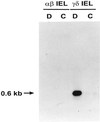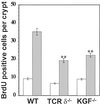Protection of the intestinal mucosa by intraepithelial gamma delta T cells
- PMID: 12376619
- PMCID: PMC137885
- DOI: 10.1073/pnas.212290499
Protection of the intestinal mucosa by intraepithelial gamma delta T cells
Abstract
gammadelta intraepithelial T lymphocytes (IEL) represent a major T cell population within the intestine of unclear functional relevance. The role of intestinal gammadelta IEL was evaluated in the dextran sodium sulfate (DSS) induced mouse colitis model system. Large numbers of gammadelta T cells, but not alphabeta T cells, were localized at sites of DSS-induced epithelial cell damage. gammadelta IEL in DSS treated mice expressed keratinocyte growth factor (KGF), a potent intestinal epithelial cell mitogen. gammadelta cell-deficient mice (TCRdelta(-/-)) and KGF-deficient mice (KGF(-/-)), but not alphabeta cell-deficient mice (TCRalpha(-/-)), were more prone than wild-type mice to DSS-induced mucosal injury and demonstrated delayed tissue repair after termination of DSS treatment. Termination of DSS treatment resulted in vigorous epithelial cell proliferation in wild-type mice but not in TCRdelta(-/-) mice or KGF(-/-) mice. These results suggest that gammadelta IEL help preserve the integrity of damaged epithelial surfaces by providing the localized delivery of an epithelial cell growth factor.
Figures







Similar articles
-
Protection against colitis by CD100-dependent modulation of intraepithelial γδ T lymphocyte function.Mucosal Immunol. 2014 Jan;7(1):134-42. doi: 10.1038/mi.2013.32. Epub 2013 May 22. Mucosal Immunol. 2014. PMID: 23695512 Free PMC article.
-
Glutamine modulates acute dextran sulphate sodium-induced changes in small-intestinal intraepithelial γδ-T-lymphocyte expression in mice.Br J Nutr. 2014 Mar 28;111(6):1032-9. doi: 10.1017/S0007114513003425. Epub 2013 Nov 14. Br J Nutr. 2014. PMID: 24229607
-
Aggravation of intestinal inflammation by depletion/deficiency of gammadelta T cells in different types of IBD animal models.J Leukoc Biol. 2007 Jan;81(1):168-75. doi: 10.1189/jlb.1105696. Epub 2006 Oct 13. J Leukoc Biol. 2007. PMID: 17041003
-
[T gamma-delta lymphocytes and their role in hypersensitivity processes in the digestive and respiratory mucosa].Allergol Immunopathol (Madr). 2002 Sep-Oct;30(5):273-82. Allergol Immunopathol (Madr). 2002. PMID: 12396962 Review. Spanish.
-
Epithelial and mucosal gamma delta T cells.Curr Opin Immunol. 2006 Oct;18(5):534-8. doi: 10.1016/j.coi.2006.06.001. Epub 2006 Jul 11. Curr Opin Immunol. 2006. PMID: 16837181 Review.
Cited by
-
The role of growth factors in intestinal regeneration and repair in necrotizing enterocolitis.Semin Pediatr Surg. 2013 May;22(2):101-11. doi: 10.1053/j.sempedsurg.2013.01.007. Semin Pediatr Surg. 2013. PMID: 23611614 Free PMC article. Review.
-
Immunoregulation by the gut microbiota.Cell Mol Life Sci. 2012 Nov;69(21):3635-50. doi: 10.1007/s00018-012-0993-6. Epub 2012 Apr 22. Cell Mol Life Sci. 2012. PMID: 22527722 Free PMC article. Review.
-
Prospects for chimeric antigen receptor (CAR) γδ T cells: A potential game changer for adoptive T cell cancer immunotherapy.Cancer Lett. 2016 Oct 1;380(2):413-423. doi: 10.1016/j.canlet.2016.07.001. Epub 2016 Jul 5. Cancer Lett. 2016. PMID: 27392648 Free PMC article. Review.
-
Deletion of cationic amino acid transporter 2 exacerbates dextran sulfate sodium colitis and leads to an IL-17-predominant T cell response.Am J Physiol Gastrointest Liver Physiol. 2013 Aug 1;305(3):G225-40. doi: 10.1152/ajpgi.00091.2013. Epub 2013 May 23. Am J Physiol Gastrointest Liver Physiol. 2013. PMID: 23703655 Free PMC article.
-
γδ T cells: origin and fate, subsets, diseases and immunotherapy.Signal Transduct Target Ther. 2023 Nov 22;8(1):434. doi: 10.1038/s41392-023-01653-8. Signal Transduct Target Ther. 2023. PMID: 37989744 Free PMC article. Review.
References
Publication types
MeSH terms
Substances
LinkOut - more resources
Full Text Sources
Other Literature Sources
Molecular Biology Databases

